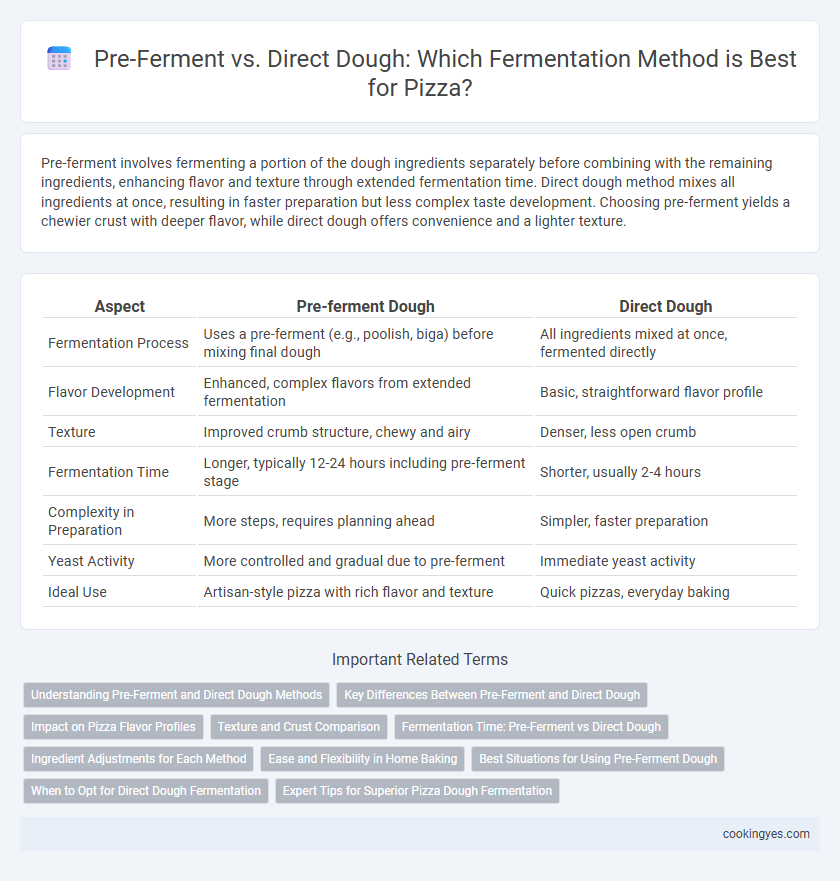Pre-ferment involves fermenting a portion of the dough ingredients separately before combining with the remaining ingredients, enhancing flavor and texture through extended fermentation time. Direct dough method mixes all ingredients at once, resulting in faster preparation but less complex taste development. Choosing pre-ferment yields a chewier crust with deeper flavor, while direct dough offers convenience and a lighter texture.
Table of Comparison
| Aspect | Pre-ferment Dough | Direct Dough |
|---|---|---|
| Fermentation Process | Uses a pre-ferment (e.g., poolish, biga) before mixing final dough | All ingredients mixed at once, fermented directly |
| Flavor Development | Enhanced, complex flavors from extended fermentation | Basic, straightforward flavor profile |
| Texture | Improved crumb structure, chewy and airy | Denser, less open crumb |
| Fermentation Time | Longer, typically 12-24 hours including pre-ferment stage | Shorter, usually 2-4 hours |
| Complexity in Preparation | More steps, requires planning ahead | Simpler, faster preparation |
| Yeast Activity | More controlled and gradual due to pre-ferment | Immediate yeast activity |
| Ideal Use | Artisan-style pizza with rich flavor and texture | Quick pizzas, everyday baking |
Understanding Pre-Ferment and Direct Dough Methods
Pre-ferment involves fermenting a portion of the dough ingredients separately before mixing the final dough, enhancing flavor complexity and dough strength through longer fermentation times. Direct dough method mixes all ingredients at once, resulting in faster fermentation and a simpler process but with less developed flavor and texture. Mastery of both methods allows pizza makers to control fermentation time, flavor profile, and dough elasticity for optimal pizza crust quality.
Key Differences Between Pre-Ferment and Direct Dough
Pre-ferment involves fermenting a portion of the dough ingredients ahead of full dough mixing, enhancing flavor development, gluten strength, and fermentation control. Direct dough mixes all ingredients simultaneously, leading to faster fermentation but less complexity in taste and texture. Pre-fermented dough typically results in a chewier crust with improved aroma, while direct dough is favored for quick preparation and consistent rise.
Impact on Pizza Flavor Profiles
Using pre-ferment in pizza dough fermentation enhances flavor complexity by allowing yeast and bacteria more time to develop organic acids and alcohol, resulting in a tangy, slightly sour crust with deeper aroma. Direct dough fermentation, with shorter fermentation times, produces a milder, cleaner flavor profile that emphasizes the natural sweetness of the flour. The choice between pre-ferment and direct dough significantly influences the balance of taste, texture, and aroma in the final pizza crust.
Texture and Crust Comparison
Pre-ferment dough develops a more complex flavor profile and a chewier, airier texture due to longer fermentation and gluten development, resulting in a crispier and more blistered crust with enhanced browning from caramelized sugars. Direct dough fermentation produces a denser crumb and a softer crust texture with less nuanced flavor, as the shorter fermentation limits gluten and yeast activity. The choice between pre-ferment and direct dough methods significantly impacts the crust's texture, chewiness, and overall taste quality in pizza.
Fermentation Time: Pre-Ferment vs Direct Dough
Pre-ferment dough requires a longer fermentation time, typically ranging from 12 to 24 hours, allowing yeast to develop complex flavors and improve texture. Direct dough fermentation is shorter, usually between 1 to 3 hours, providing faster preparation but less depth in taste. Extended pre-fermentation enhances gluten structure and dough digestibility compared to the quicker direct dough method.
Ingredient Adjustments for Each Method
Pre-ferment fermentation requires precise ingredient adjustments, including reduced yeast quantities and increased hydration levels to support extended fermentation times and enhanced flavor development. Direct dough methods use higher yeast amounts and standard hydration to accelerate fermentation and streamline production. Adjusting sugar and salt levels is also critical to balance fermentation speed and dough strength according to the chosen method.
Ease and Flexibility in Home Baking
Pre-ferment methods like poolish or biga offer enhanced flavor and improved texture but require advanced planning and precise timing, which can be challenging for home bakers seeking convenience. Direct dough fermentation simplifies the process by combining all ingredients at once, providing greater ease and flexibility for spontaneous baking without compromising fermentation quality significantly. Home bakers prioritizing quick setup and adaptability often prefer direct dough, while those aiming for artisanal taste may opt for pre-ferments despite the increased preparation time.
Best Situations for Using Pre-Ferment Dough
Pre-ferment dough enhances fermentation flavor and texture, making it ideal for artisan or Neapolitan-style pizzas where a complex, airy crust is desired. It suits longer preparation times and controlled environments, such as pizzerias focused on quality over speed. Pre-fermented dough also improves shelf life and dough extensibility, benefiting high-volume operations with advanced proofing schedules.
When to Opt for Direct Dough Fermentation
Direct dough fermentation is ideal when time constraints demand a faster process, as it skips the pre-ferment stage and allows dough to be mixed and fermented in a single step, typically taking 1 to 2 hours. This method suits casual pizza makers or restaurants requiring consistent daily batches without long fermentation schedules. Direct dough fermentation also works well for doughs with high yeast content or enriched recipes, where flavor development from extended fermentation is less critical.
Expert Tips for Superior Pizza Dough Fermentation
Pre-ferment dough, such as poolish or biga, enhances flavor complexity and improves dough extensibility by allowing yeast and enzymes to develop over 12 to 24 hours at controlled temperatures. Direct dough methods involve mixing all ingredients at once, resulting in faster preparation but less depth in taste and texture. Expert pizza makers recommend cold fermentation for 48 to 72 hours using pre-ferments, which yields superior gluten structure, aromatic profiles, and a perfectly airy crust.
Pre-ferment vs Direct dough for fermentation Infographic

 cookingyes.com
cookingyes.com